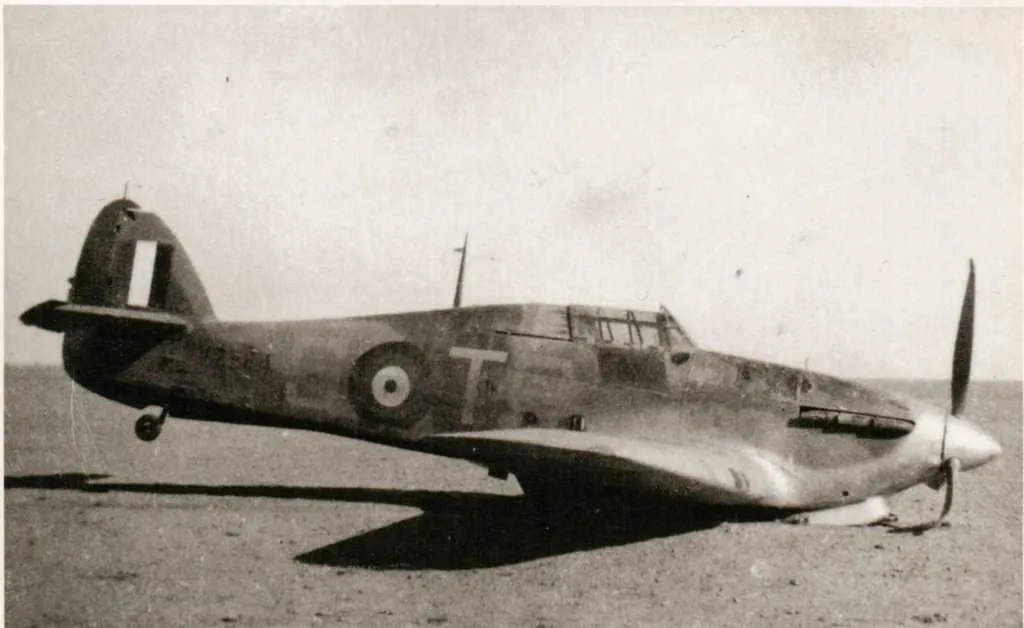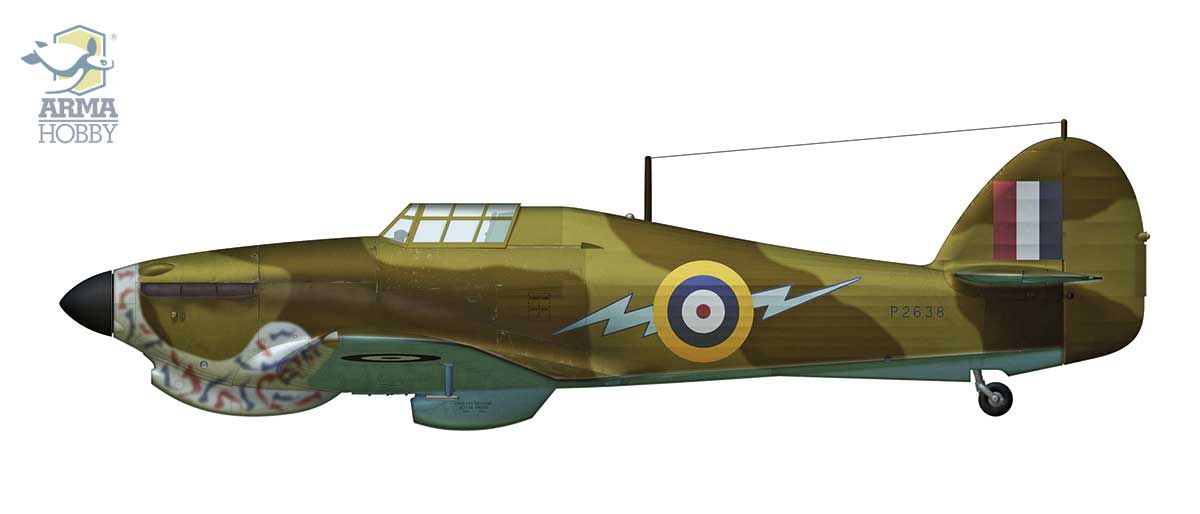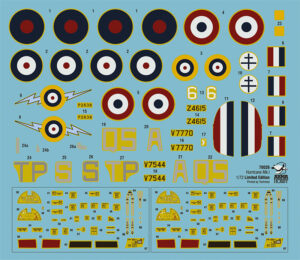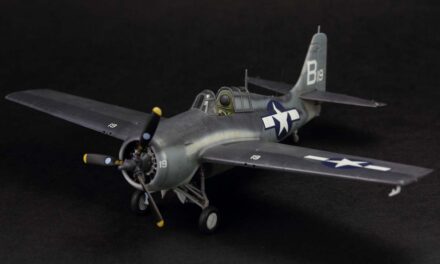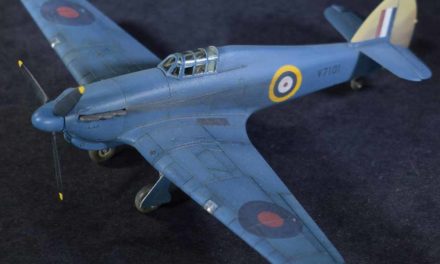The description of the paint scheme applied to the French Hurricane Z4615 that I presented in my previous article was intended to encourage modellers to build a most originally marked and painted replica. However, the kit also contains three other paint schemes, which, I sincerely hope, will make your choice very difficult. As a great fan of this aircraft, I could of course recommend that you buy a second kit or use the additional frames and construct at least one more interestingly coloured tropical Hurricane model.
All four presented aeroplanes have something in common with each other. And I am not referring here just to the fact that they are tropical Hurricanes which fought in Egypt and Libya. V7770, together with Z4615, later served with GC 1 “Alsace”, and its pilot, F/O John Jackson, mentioned in his memoirs how the Hurricane looked in what modellers have come to know as the “sand and spaghetti” camouflage, which was also applied to the two other aircraft from our kit: V7544 and P2638. Further, the pilot of V7544, F/O James Eric “Jas” Storrar, who was temporarily assigned to No. 3 Squadron RAAF, carried out operational flights together with the Australians, and indeed flew on missions together with V7770. And, finally, one of the operators of P2638 in No. 274 Squadron RAF was the Frenchman Jean Louis Tulasne, who went on to serve with GC 1 “Alsace” and perished in 1943 as the commander of Groupe de Chasse n° 3 Normandie-Niemen while piloting a Yakovlev Yak-1 (the Yak-1 kit offered by Arma Hobby (number 70027) contains the paint scheme of one of his aircraft). Two other Frenchmen who also flew the aeroplane were Flt Lt Paul Jaquier and F/Sgt Le Bois. Later, a wholly French flight was created within the squadron, thus commencing a period of organizational independence of the French aviators, the majority of whom had escaped from Syria following the Fall of France. As you can see, therefore, the story is made up a multitude of wefts and strands. But some of its aspects are darker: F/O Jackson shot down a Potez 63 from the Vichy Air Force, while in 1941 Hurricane Z4615, operated by No. 260/450 Squadron, fought against the same foe in Operation Exporter – the British invasion of Syria and Lebanon.
Hurricane Mk.I trop V7770/OS-A, 3 SquadronRAAF, F/O John Francis Jackson, Benina, February 1941. Artowrk by Zbyszek Malicki.
The Peculiarities of V7770
V7770 carrying the paint scheme presented in the instruction is dated towards the end of February 1941. This would be confirmed by the victory markings indicating Junkers Ju 87s which Jackson downed on 18 February 1941. But it is not fully clear why only two swastikas were painted behind the boomerang. At the time, Jackson reported one aircraft shot down and two damaged; his claims were verified and he was awarded three confirmed kills. Perhaps these were the victory markings of another Australian aviator, F/O John H. W. Saunders, who destroyed two Stukas in the same engagement while flying V7770? Although the fighters were not permanently assigned to specific pilots, Jackson performed the majority of his operational flights on V7770, and that is why his name figures in the description. But the uncertainty remains as to whose victory markings are stencilled to the side of V7770.
The sole known photograph of this aeroplane from its period of service with the Australian squadron (link) brings to light two other curious details. First of all, No. 3 Squadron RAAF used the code letters OS. In the picture, however, we see that the letter “O” has been converted into a “Q”. Did Jackson allow himself the liberty of customizing the official designation in order for it to remind him of his home state, Queensland?
The other non-standard element are the gas patches visible on both wings. We usually find that these yellow squares were present on one wing, if at all. It cannot be excluded, however, that such a placement of two patches was the more common practice. There are not very many photographs showing both wings of a Hurricane, and so this is yet another enigmatic contribution to the history of the paint schemes and markings of British fighters.
The aircraft was factory-provided with a Temperate Land Scheme (TLS) camouflage. The process of repainting fighters operating in Egypt and Libya in Desert Scheme, with the Dark Green being replaced by the new Middle Stone colour, commenced in January 1941. Previously, the aircraft would be painted in the same scheme as those stationed in Great Britain. Some even had a black underside of the left wing, which was introduced in Europe in November 1940.
Two Different Spaghettis
In the beginning of 1941, Hurricanes in North Africa started to receive the “sand and spaghetti” camouflage, which was unique to that theatre of operations.
I am not exactly sure where the idea for this paint scheme came from. Theories abound, and I am unable to state with any conviction which is closest to the truth. In any case the “spaghetti”, which covered the front of the fuselage and the front part of the wings, and was first applied to Fairey Fulmars of the Fleet Air Arm, became widely used on desert Hurricanes in the first half of 1941. For modellers, the colours that were employed were for long a mystery. The silver background upon which the strings of pasta were set soon became a standard element (with certain exceptions), but the colour of the dots, stripes and snaking lines was for long unknown. Intuitively, we could expect them to be camouflage hues – brown, sandy beige, and green. However, a fragment of Jackson’s memoirs unexpectedly complicated the matter. Under the entry for 24 January 1941, he wrote:
Took delivery of six Hurricanes, and aren’t they beauties! The new type of mottled blue, grey and purple camouflage – on the nose, leading edges of wings and front surfaces – looks most peculiar. (link)
Were these colours applied always and everywhere? Most probably not. We made use of Jackson’s description when reconstructing P2638, but while working on V7544 we came to the conclusion – after a great deal of thought – that it could have been otherwise. F/O Storrar’s aircraft, which crashed on 14 February 1941 and has been shown on photographs (from both sides) in The History of 73 Squadron RAF by Don Minterne, a copy of which was made available to me by Dominik Sędziak, is lit up so brightly that the patches on the fuselage have completely disappeared from the silver background. But they can be seen on the shaded under-surface of the wing. While the patches are most definitely there, their subtlety would suggest that they were painted in either Dull Red or Blue. Red would have been more strongly visible on the orthochromatic film. We therefore assessed the probability and chose a lighter camouflage hue. Despite the fact that we devoted a great deal of time to analysing a large group of photographs of aircraft with this paint scheme, a serious margin of interpretative error remains, and this provides modellers with an opportunity to show what they can do. Irrespective of the colours which you choose, the tropical Hurricane in “silver and spaghetti” garb will certainly be the pride of your collection.
Hurricane Mk.I trop V7544/TP-S, 73 Squadron RAF, P/O James Eric ”Jas” Storrar. Gazala, February 1941. Artwork by Zbyszek Malicki.
V7544
In the photograph, Storrar’s aeroplane is shown on its belly. On 14 February 1941, after a short flight from El Adem to Gazala, the pilot made a textbook landing without extending his undercarriage or flaps. He freely admitted that it had been an error on his part, due to him both being tired by the intensity of military service and having drunk a beer along with his meal shortly before take-off. Years later he recalled that he had been forced to expiate his mistake by standing everyone drinks at the canteen over the next few days.
On the date of the accident the unit was being visited by journalists who were accompanied by a photographer. It is thanks to this fortuitous circumstance that the consequences of the belly-landing – a manoeuvre which, clearly, befell even the most experienced pilots – have been recorded on film.
When reconstructing the aircraft, we were faced with questions concerning various details and, correspondingly, our team had to come up with a variety of answers. Regarding the appearance of the “spaghetti”, we were unanimous that the problem arose when attempting to account for the obviously lighter colour of the letter “T” on the right side. Not having seen a picture of the other side of the fuselage, we leaned towards the explanation that this was the result of a sprucing up of the squadron’s code. But everything became more or less clear once we obtained a photograph of the left side. Here I will present my view on the matter, stressing that this is my personal interpretation. The letter “T” on the right side was simply left on the old DE camouflage hue, while the remaining letters vanished under the new colour which covered the Dark Green when the aircraft was repainted with a desert camouflage. They were subsequently recreated using a paint with a distinctly darker tone, while only the fragments of letters situated atop the Middle Stone were added on the left side. Thus, the entire letter “S” and the upper portions of the remaining letters are brighter on the left. The proper execution of this marking would have necessitated painting the code letters in two tones of Medium Sea Gray.
As I have already mentioned, the aircraft was repainted. Proof of this is that the frame of the cockpit canopy was left in the original Dark Green, as was in all probability the panel on the right side of the cockpit, which is visibly darker than the rest of the aeroplane.
Hurricane Mk.I trop P2638, 274 Sqaudron RAF, Gerawala April-May 1941. Artowrk by:Zbyszek Malicki.
P2638
The aircraft had a long career in the tropical theatre of operations, being among the first Hurricanes delivered to Africa already in September 1940. Its characteristic feature is the old-model antenna mast, which was fitted to the early production variant. Recreated, it looks as it would have in April/May 1941, when the aeroplane was flown by No. 274 Squadron RAF. It too is closely associated with the story of the Free French, for many of their pilots served in the unit before a purely French squadron was established.
In the case of P2638, the sole riddle concerned the colour of the lightning bolt on its side. Previously, the interpretation had been that it was yellow, white, or blue. Once our analysis excluded the first two, we came to the conclusion that it was most probably coloured blue, in all likelihood using the same paint that was applied to the underside of the aircraft.
Photo: ex IMW/Crown Copyright.
The “spaghetti” on this fighter could have been the classic version described by Jackson. The colour which Jackson called “purple” was like enough the ordinary Dull Red used for painting identification markings. A thin layer placed on the silver background would have indeed looked purple.
For me, stories such as these make building aircraft models a fascinating journey through time, acting as an impulse to learn the stories of individuals and entire nations.
And I consider the present kit, closely associated with the history of the Free French Air Forces, as one of the most interesting to have been produced by Arma Hobby to date. First and foremost because of the twisted fates of the pilots and the uniquely original appearance of their aircraft.
English Translation by Maciek Zakrzewski
See also:
- Hurricane Mk I trop „Western Desert” Limited Edition and other Hurricane model kits in the Arma Hobby shop
Hurricane I trop z 73 Dywizjonu – Galeria – Thibault Choquart
Model maker for 45 years, now rather a theoretician, collector and conceptual modeller. Brought up on Matchbox kits and reading "303 Squadron" book. An admirer of the works of Roy Huxley and Sydney Camm.
This post is also available in:
 polski
polski






